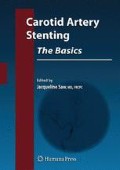Abstract
Carotid artery stenting is of interest to physicians of varied backgrounds and expertise. Although disparate guidelines with important ideological differences exist regarding operator training, they share several important features in common. All professional society guidelines are of the unanimous opinion that patient safety is paramount. There is general agreement that formal training which imparts an adequate depth of cognitive knowledge of the cerebral vasculature and its associated pathophysiologic processes, as well as technical aptitude with cervicocerebral angiography and carotid intervention, including the management of complications, is the cornerstone for the successful care of patients requiring CAS.
Access this chapter
Tax calculation will be finalised at checkout
Purchases are for personal use only
References
ACCF/SCAI/SVMB/SIR/ASITN 2007 Clinical Expert Consensus Document on Carotid Stenting. JACC 2007;49(1):2007:126–170.
Connors JJ III, Sacks D, Furlan AJ, Selman WR, Russell EJ, Stieg PE, Hadley MN. For the NeuroVascular Coalition Writing Group. Radiology 2005;234:26–34.
Davies KN, Humphrey PR. Complications of cerebral angiography in patients with symptomatic carotid territory ischemia screened by carotid ultrasound. J Neurol Neurosurg Psychiatry 1993;56:9647–9672.
Mani RL, Eisenberg RL. Complications of catheter cerebral arteriography: analysis of 5000 procedures. II. Relation of complication rates to clinical and arteriographic diagnoses. AJR Am J Roentgenol 1978;131:867–869.
McIvor J, Steiner TJ, Perkins GD, et al. Neurological morbidity of arch angiography in cerebrovascular disease. The influence of contrast medium and the radiologist. Br J Radiol 1987;60:117–122.
Dion JE, Gates PC, Fox AJ, et al. Clinical events following neuroangiography: a prospective study. Stroke 1987;18:997–1004.
White CJ. Training and certification for carotid stenting: is the fox guarding the hen house? Catheter Cardiovasc Interv 2005;66:50–51.
Patel AD, Gallagher AG, Nicholson WJ, Cates CU. Learning curves and reliability measures for virtual reality simulation in the performance of carotid angiography. J Am Coll Cardiol 2006;47:1796–1802.
Dayal R, Faries PL, Lin SC, et al. Computer simulation as a component of catheter-based training. J Vasc Surg 2004;40:1112–1117.
Dawson D, Meyer J, RCIS, et al. Training with simulation improves residents’ endovascular procedure skills. J Vasc Surg 2007;45:149–154.
Executive Committee for the Asymptomatic Carotid Atherosclerosis Study. Endarterectomy for asymptomatic carotid artery stenosis. JAMA 1995;273:1421–1428.
Cooperative Study between the ASNR, ASITN, and SCVIR. Quality improvement guidelines for adult diagnostic neuroangiography. AJNR Am J Neuroradiol 2000;21:146–150.
Standard for the performance of diagnostic cervicocerebral angiography in adults. Res. 5-1999. American College of Radiology Standards 2000–2001. Reston VA: ACR, 2000;415–426.
Gomez CR, Kinkel P, Masdeu JC, et al. American Academy of Neurology guidelines for credentialing in neuroimaging. Report from the task force on updating guidelines for credentialing in neuroimaging. Neurology 1997;49:1734–1737.
Higashida RT, Hopkins LN, Berenstein A, et al. Program requirements for residency/fellowship education in neuroendovascular surgery/interventional Neuroradiology: a special report on graduate medical education. AJNR Am J Neuroradiol 2000;21:1153–1159.
Bakshi R, Alexandrov AV, Gomez CR, Masdeu JC. Neuroimaging curriculum for neurology trainees: report from the Neuroimaging Section of the AAN. J Neuroimaging 2003;13:215–217.
Author information
Authors and Affiliations
Editor information
Editors and Affiliations
Rights and permissions
Copyright information
© 2009 Humana Press, a part of Springer Science+Business Media, LLC
About this chapter
Cite this chapter
Alquoofi, F., Kanani, R.S. (2009). Operator Training and Accreditation. In: Saw, J. (eds) Carotid Artery Stenting: The Basics. Contemporary Cardiology. Humana Press, Totowa, NJ. https://doi.org/10.1007/978-1-60327-314-5_8
Download citation
DOI: https://doi.org/10.1007/978-1-60327-314-5_8
Published:
Publisher Name: Humana Press, Totowa, NJ
Print ISBN: 978-1-60327-313-8
Online ISBN: 978-1-60327-314-5
eBook Packages: MedicineMedicine (R0)

